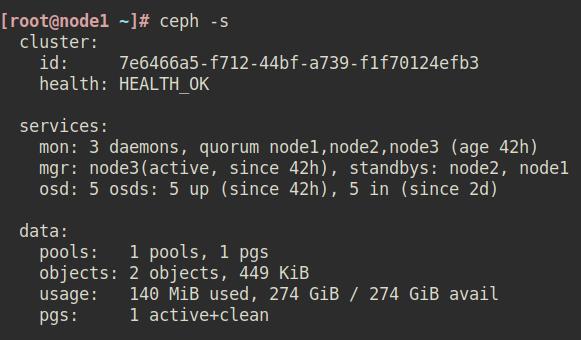I’ve been experimenting with microceph & more briefly with cephadm (with services running in podman) on a 5 x node “low end” cluster - these details are probably more interesting for people with nodes having single disks who still want to run ceph. TLDR - I’m going to be using microceph for various reasons:
-
For your cluster you want at least 2 x NIC’s ideally with a
10gbor greater internal network forceph -
5 x node clusters will have better performance than 3 x node clusters.
-
microcephuses around1.5gbof RAM on monitor nodes &500mbon the other nodes -
microcephclusters reboot much faster (less than 10 seconds onnvme) - thancephadmnodes (the services inpodmantook much longer to stop -30to60seconds or so) -
cephadmuses a lot more disk (as it’s running a complete Centos 8 stream system in each container) - RAM usage was similar tomicroceph -
cephadmwill not install directly onto partitions - it requireslvmlv’s -
install
podmanthenapt install cephadm --no-install-recommends(to avoid pulling indocker) - ubuntu23.10gives youpodman v4from the official repos now. You probably want to usedockerwithcephadm- mycephadmcluster never became healthy (mgrkept crashing - possibly due to usingpodman?) -
Rather than going by the
microcephdocs - usemicroceph initto initialise every node so you can choose the specific ip address to runcephon (otherwise by default it will use yourpublicinterfaces)
These are the basic steps I use to get microceph running on disk partitions (partition fix from original discussion on Github):
Microceph notes
===============
# opening outbound destination ports
# tcp 3300 6789 6800-6850 7443
# 3300 is the new messenger v2 port (tcp 6789 is v1)
----------------------------------------------------
# put apparmor in complain mode so microceph init works
-------------------------------------------------------
echo -n complain > /sys/module/apparmor/parameters/mode
# installation
---------------
snap install microceph --channel reef/stable
snap refresh --hold microceph
# allow OSD to install on partitions
-------------------------------------------------------
systemctl edit snap.microceph.osd --drop-in=override
[Unit]
ExecStartPre=/path/to/osdfix
-------------------------------------------------------
# the script I use to fix the osd service
-----------------------------------------
* There are actually 3 snap profiles that mention virtio
* (see commented out $PROFILES & $FILES below)
* I found only the osd profile needs changing for partitions to work.
* Just change $ADD to a rule that makes sense for your disks
* As sed is inserting a line you don't need to escape forward slashes in $ADD
#!/bin/sh
TAG="Cephy"
ADD="/dev/vda[4-9] rwk,\t\t\t\t\t # $TAG"
SEARCH="/dev/vd\[a-z\]"
#PROFILES="/var/lib/snapd/apparmor/profiles/snap.microceph*"
#FILES=$(grep -l $SEARCH $PROFILES)
FILES="/var/lib/snapd/apparmor/profiles/snap.microceph.osd"
for file in $FILES; do
if ! grep -q $TAG $file; then
line=$(grep -n $SEARCH $file | cut -d : -f 1)
sed -i "$line i $ADD" $file
echo "Reloading: $file"
apparmor_parser -r $file
else
echo "Already configured: $file"
fi
done
exit 0
-----------------------------------------------------------------------------------
# first node say yes to cluster & add names of additional nodes to see join tokens:
-----------------------------------------------------------------------------------
microceph init
# example partition paths (for a VPS)
-------------------------------------
/dev/disk/by-path/virtio-pci-0000:00:05.0-part4
# additional nodes say no to cluster & provide token from previous step
-----------------------------------------------------------------------
microceph init
------------------------------------------------------------------------------------
# my previous microceph testing - long story short:
# the defaults give good performance
# with an internal network for ceph no need to go crazy on security
https://discuss.linuxcontainers.org/t/introducing-microceph/15457/47?u=itoffshore
------------------------------------------------------------------------------------
# useful commands
-----------------
microceph disk list
microceph cluster list
microceph cluster config list
ceph osd lspools
ceph osd tree
Hopefully these notes save people some time:
-

-
I found
microcephcompletely stable running for weeks on end (until I thought it was a good idea to trycephadm )
) -
I also upgraded
microcephfromquincytoreefwith zero problems
I will be continuing with incus & ovn-central - I did also try microovn but this seems to be better used with microcloud.
I got the cluster uplink network running without too much trouble - I just need to figure out how to give each chassis a memorable name (as microovn does by default)
